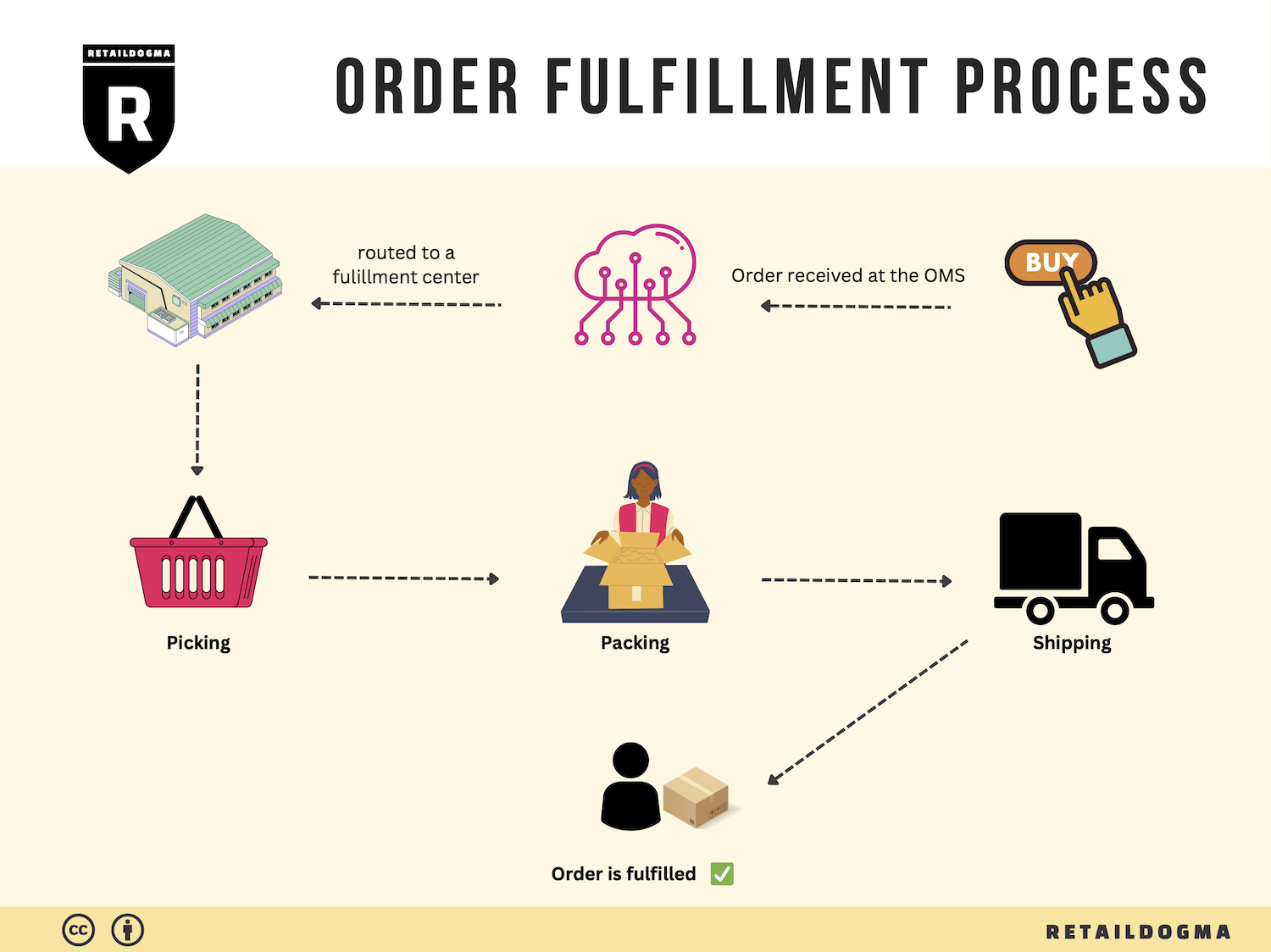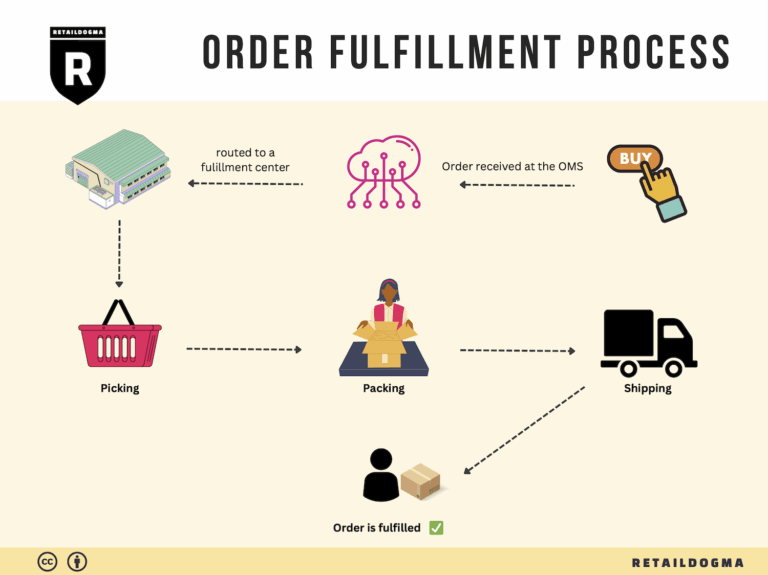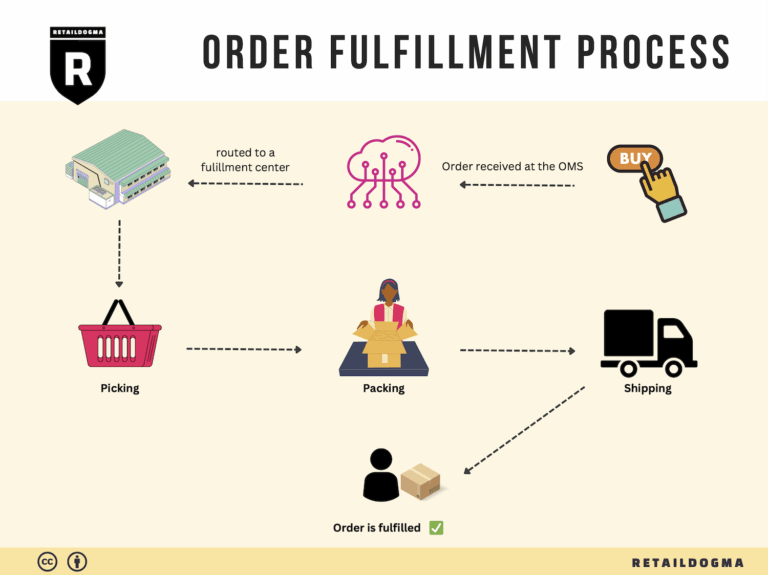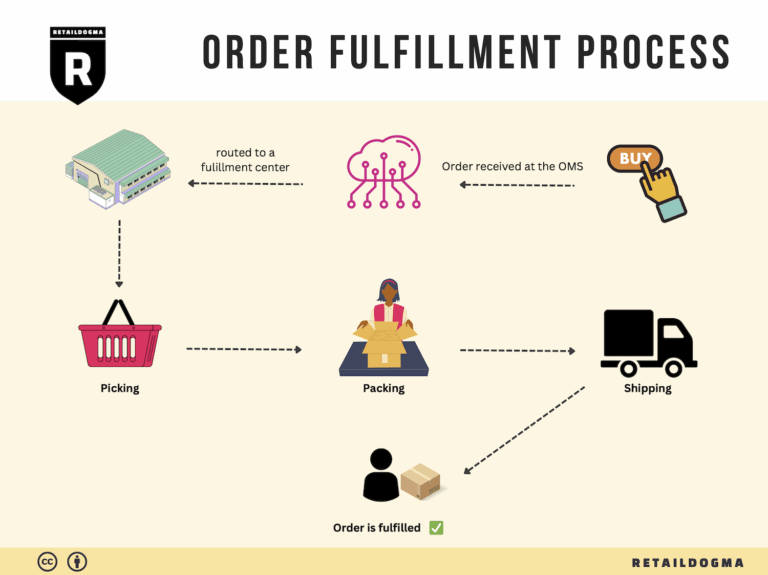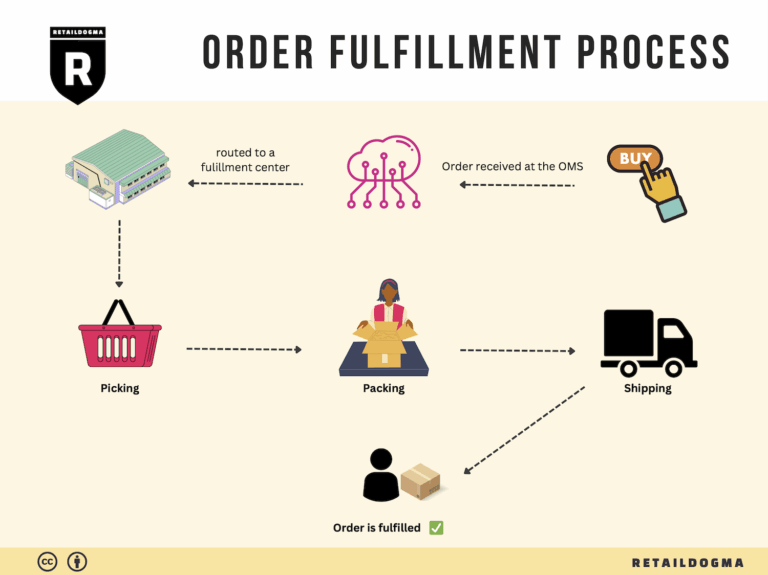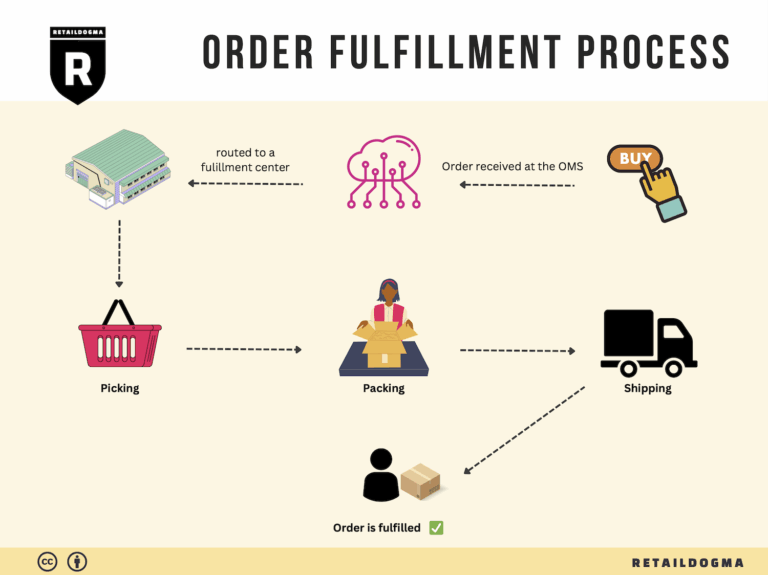What Is A Fulfillment Center? A Complete Guide (2025)
What is E-commerce Fulfillment? An Introduction for Growing Businesses
Understanding E-commerce Fulfillment
As an e-commerce business owner, one of the most daunting challenges you may face is managing the logistics of packing and shipping orders. The thrill of making sales can quickly turn into a headache as you grapple with inventory management, packing materials, shipping labels, and the actual shipping process. Overwhelmed by these tasks, many entrepreneurs find themselves wishing they could focus more on growing their business rather than getting bogged down in the minutiae of order fulfillment.
E-commerce fulfillment is fundamentally the process of getting a product into the hands of a customer after they make a purchase. This includes everything from inventory storage and order processing to packing and shipping, as well as handling returns. Understanding how to streamline this process is crucial for scaling your online business effectively.
In this guide, we will explore the various fulfillment models available to you, such as third-party logistics (3PL) and Fulfillment by Amazon (FBA). Each model has its own advantages and considerations, and choosing the right one can significantly impact your operational efficiency and customer satisfaction.
We will also delve into the core services involved in e-commerce fulfillment. This includes inventory management, order processing, packing, shipping, and customer service. By understanding these components, you can better evaluate your current processes and identify areas for improvement.
Choosing the right fulfillment partner is another critical aspect we will cover. We’ll discuss key factors to consider, such as location, technology, reliability, and pricing. A well-chosen partner can help you scale your operations while maintaining the quality of service your customers expect.
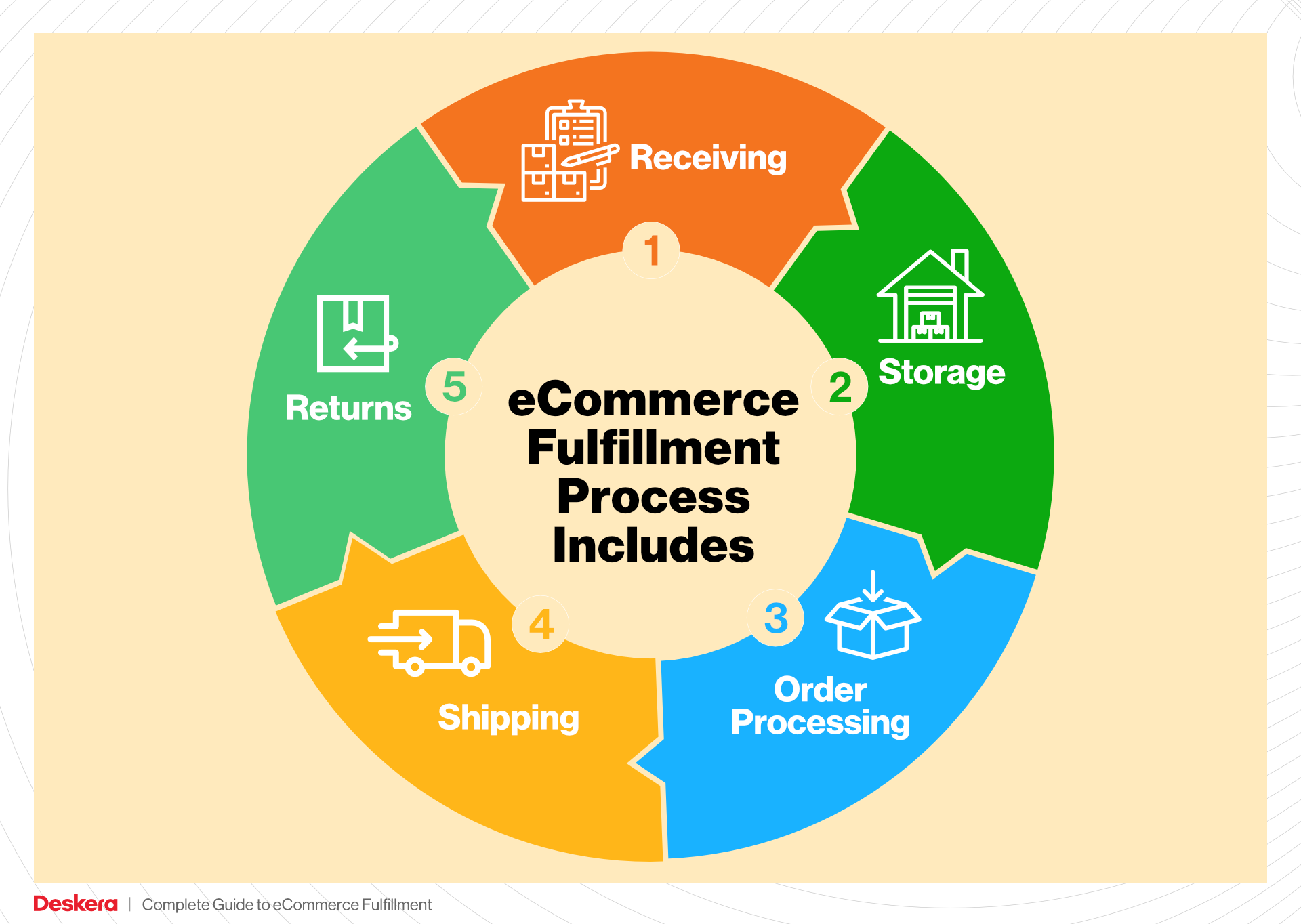
Finally, we will examine pricing models in fulfillment, helping you understand the costs associated with different fulfillment strategies. This knowledge will empower you to make informed financial decisions that align with your business goals.
The ultimate goal of this guide is to equip you with the insights needed to make smart decisions about your logistics. By optimizing your e-commerce fulfillment process, you can free up valuable time and resources, allowing you to focus on what truly matters: growing your business. Whether you are just starting or looking to scale, understanding e-commerce fulfillment is essential to your success.
What You’ll Learn In This Guide
- What is E-commerce Fulfillment? An Introduction for Growing Businesses
- The Order Fulfillment Process: From ‘Buy’ Button to Customer’s Door
- Comparing Fulfillment Models: In-House vs. 3PL vs. Dropshipping
- A Deep Dive into Amazon FBA: Pros, Cons, and Who It’s For
- Core Services Offered by Fulfillment Centers
- How to Choose a Fulfillment Partner: A 6-Point Checklist
- Understanding Fulfillment Pricing: A Breakdown of Common Fees
- Frequently Asked Questions (FAQs) about Fulfillment
- Conclusion: Is Outsourcing Fulfillment the Right Move for Your Business?
- Important Disclaimer
The Order Fulfillment Process: From ‘Buy’ Button to Customer’s Door
1. Receiving Inventory
The order fulfillment process begins with receiving inventory, a crucial first step that ensures products are correctly accounted for and ready for storage. When goods arrive at the fulfillment center, they are checked against purchase orders to verify quantities and conditions. This is where key terms like SKU (Stock Keeping Unit) come into play, as each product is tagged with a unique SKU for easy identification.
Receiving inventory is essential because it sets the foundation for accurate stock levels and future order fulfillment. If discrepancies occur during this stage—such as damaged goods or incorrect quantities—these issues must be addressed immediately to avoid complications later in the process. Efficient receiving operations also reduce lead times, allowing businesses to replenish stock quickly and meet customer demand.
2. Warehouse Storage
Once inventory is received and verified, the next step is warehouse storage. Products are organized and placed in designated storage areas within the fulfillment center. This can involve various storage methods, such as pallet racking, shelving, or bin storage, depending on the size and type of products.
Effective warehouse storage is vital for maintaining order accuracy and optimizing space. Properly organized inventory allows for easy access and quick retrieval, which directly impacts order fulfillment speed. Using systems like warehouse management software (WMS) can help track inventory levels, manage locations, and facilitate stock rotation, ensuring that older products are sold first (FIFO – First In, First Out).
3. Order Picking
As customer orders are placed, the fulfillment center moves into the order picking stage. This involves retrieving the correct items from storage based on the order details. A critical tool during this phase is the pick list, which outlines the items needed for each order, including their locations within the warehouse.
Order picking is a pivotal step in the fulfillment process because it directly affects order accuracy and customer satisfaction. Errors in picking can lead to incorrect shipments, resulting in returns and dissatisfied customers. To enhance efficiency, businesses can employ various picking strategies, such as batch picking (picking multiple orders simultaneously) or zone picking (assigning pickers to specific areas of the warehouse). Automating this process with technology like pick-to-light systems can further streamline operations.
4. Order Packing
After items have been picked, they move to the order packing stage. Here, products are carefully packed into boxes or containers for shipment. This step involves not only placing the items into the appropriate packaging but also including necessary documentation, such as invoices or return labels. Businesses often utilize packing slips to ensure that all items are included in the shipment.
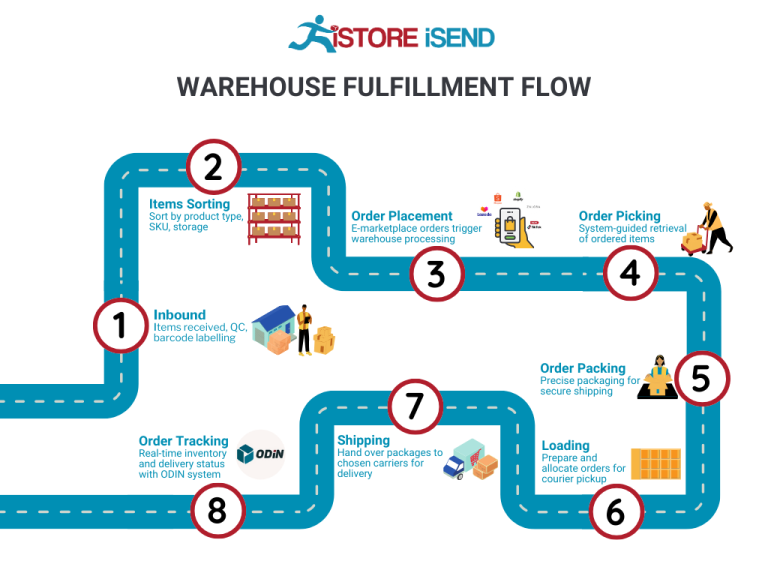
Order packing is critical for protecting products during transit and ensuring they arrive in good condition. Proper packing also helps minimize shipping costs, as choosing the right box size can reduce dimensional weight charges. Additionally, well-packed orders enhance the customer experience, as unboxing becomes a more enjoyable and professional affair.
5. Shipping & Delivery
The final step in the order fulfillment process is shipping and delivery. Once orders are packed, they are labeled and handed off to carriers for transportation. Businesses must choose appropriate shipping methods based on factors such as cost, delivery speed, and destination. Understanding terms like last-mile delivery is essential here, as it refers to the final leg of the shipping process, where packages are delivered to the customer’s doorstep.
Shipping and delivery are crucial for customer satisfaction, as timely delivery directly influences the customer’s perception of the business. Implementing tracking systems allows customers to monitor their shipments, enhancing transparency and trust. Moreover, optimizing shipping routes and carrier partnerships can lead to cost savings and improved delivery times, which are vital for scaling e-commerce operations.
By mastering each of these steps in the order fulfillment process, e-commerce businesses can enhance operational efficiency, reduce errors, and ultimately improve customer satisfaction, paving the way for growth and scalability in a competitive marketplace.
Comparing Fulfillment Models: In-House vs. 3PL vs. Dropshipping
Fulfillment Model Comparison Table
| Model | Who Handles Inventory | Best For (Business Stage) | Key Advantage | Key Disadvantage |
|---|---|---|---|---|
| In-House Fulfillment | Your own team | Startups to Medium-sized | Complete control over operations | High overhead costs and resource demand |
| Third-Party Logistics (3PL) | External logistics provider | Growth to Large-sized | Scalable solutions and expertise | Less control over inventory management |
| Dropshipping | Supplier or manufacturer | Startups to Small-sized | Low upfront investment and risk | Low margins and less brand control |
In-House Fulfillment
In-house fulfillment refers to the process where a business manages its inventory, warehousing, and shipping operations directly. This model is often utilized by startups and medium-sized businesses that require complete control over their logistics processes. One of the primary advantages of in-house fulfillment is the ability to maintain direct oversight of inventory, which can lead to improved quality control and customer service. Businesses can customize their fulfillment processes to align with their brand image and customer expectations, ensuring that every package reflects their standards.
However, this model comes with significant drawbacks. The most notable is the high overhead costs associated with maintaining a warehouse, hiring staff, and investing in technology for inventory management and order processing. Additionally, managing logistics internally demands a considerable amount of time and resources, which can detract from core business activities such as product development and marketing. Therefore, while in-house fulfillment can provide control and customization, it may not be sustainable for all businesses, especially as they scale.
Third-Party Logistics (3PL)
Third-party logistics (3PL) involves outsourcing the logistics and supply chain management functions to an external provider. This model is particularly beneficial for businesses experiencing growth or those that have reached a large size and need to streamline operations. 3PL providers bring expertise, technology, and infrastructure that can enhance operational efficiency and scalability. By leveraging the capabilities of a 3PL, businesses can focus on their core competencies while benefiting from the provider’s logistics experience, often resulting in faster delivery times and improved customer satisfaction.
On the downside, using a 3PL means relinquishing some control over inventory management and fulfillment processes. This can lead to challenges in maintaining brand consistency and quality assurance. Additionally, businesses may face complexities related to communication and coordination with the 3PL, which can impact order accuracy and fulfillment speed. While 3PLs provide significant advantages in scalability and resource management, it’s essential for businesses to choose a partner that aligns with their operational goals and quality standards.
Dropshipping
Dropshipping is a fulfillment model where a retailer does not keep goods in stock but instead transfers customer orders and shipment details to a manufacturer or wholesaler, who then ships the products directly to the customer. This model is particularly attractive for startups and small businesses due to its low upfront investment. Retailers can start selling products without the need to invest in inventory, warehouse space, or fulfillment infrastructure, which significantly reduces the financial risk involved in starting an e-commerce business.
However, dropshipping comes with its own set of challenges. The most significant disadvantage is the lower profit margins, as retailers often pay wholesale prices without having bulk purchasing power. Additionally, dropshippers have limited control over product quality, shipping times, and inventory levels, which can lead to customer dissatisfaction if issues arise. Moreover, reliance on suppliers can be risky; if a supplier runs out of stock or fails to deliver on time, it directly impacts the retailer’s reputation. Thus, while dropshipping allows for easy entry into the e-commerce market, it requires careful management of supplier relationships and customer expectations to be successful.
In summary, the choice of fulfillment model—whether in-house fulfillment, third-party logistics, or dropshipping—depends on a business’s specific needs, stage of growth, and operational strategy. Each model presents unique advantages and challenges, and business owners must weigh these factors carefully to select the most suitable approach for their logistics and fulfillment needs.
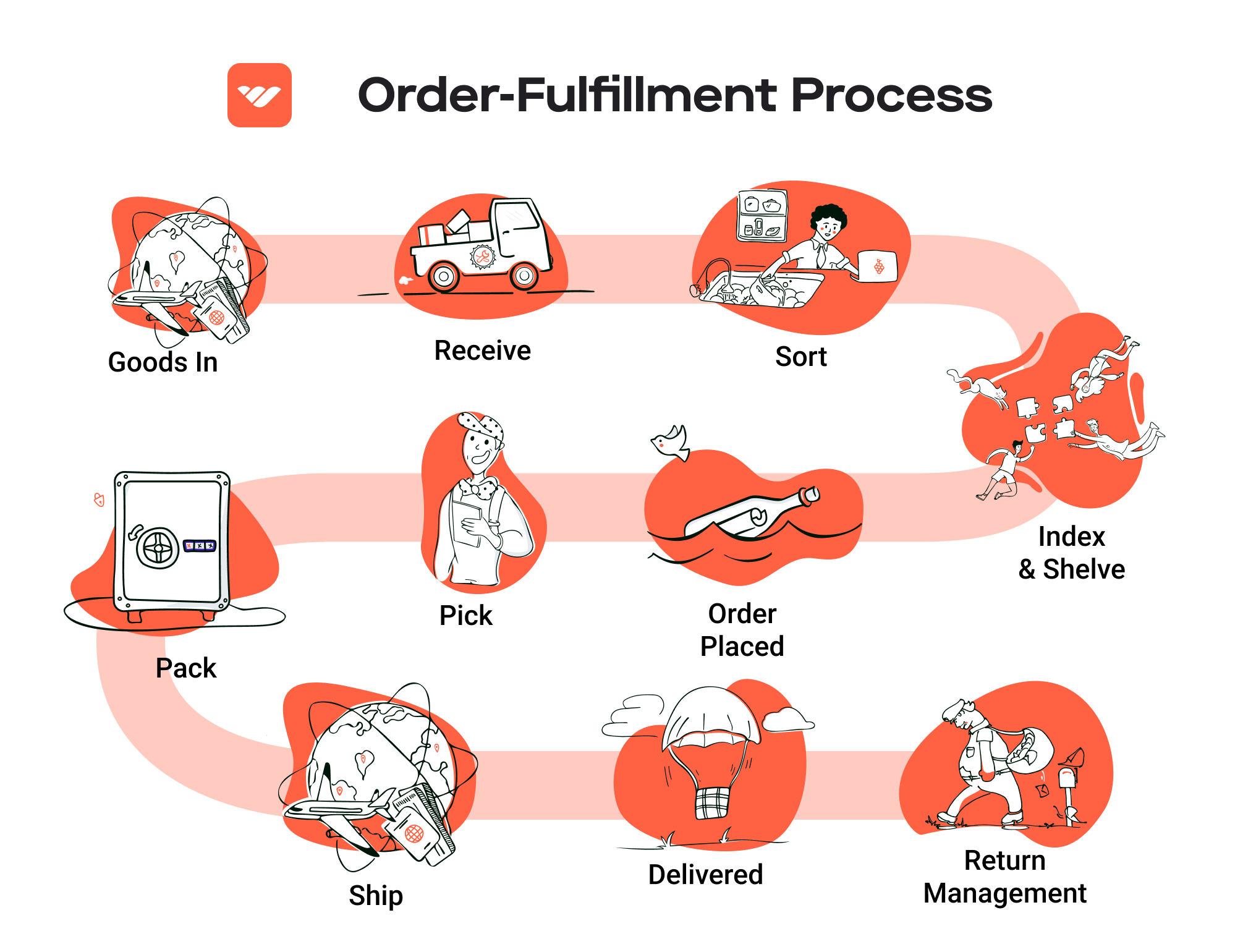
A Deep Dive into Amazon FBA: Pros, Cons, and Who It’s For
What is Fulfillment by Amazon (FBA)?
Fulfillment by Amazon (FBA) is a service provided by Amazon that enables sellers to store their products in Amazon’s fulfillment centers. When a customer orders a product, Amazon takes care of storage, packaging, shipping, and customer service on behalf of the seller. This service allows businesses, regardless of size, to leverage Amazon’s extensive logistics and distribution network to reach millions of customers worldwide.
How FBA Works
-
Product Preparation: Sellers prepare their products according to Amazon’s guidelines and ship them to designated fulfillment centers, such as RMN3 located in Fredericksburg, VA. Proper labeling and packaging are crucial to ensure smooth processing.
-
Storage: Once the products arrive at the fulfillment center, Amazon stores them until they are sold. Sellers are charged fees based on the volume of space their inventory occupies.
-
Order Processing: When a customer places an order, Amazon picks, packs, and ships the product directly to the customer. This process typically ensures faster delivery, often qualifying for Amazon Prime.
-
Customer Service: Amazon also handles all customer inquiries and returns for FBA products, which can significantly reduce the operational burden on sellers.
-
Multi-Channel Fulfillment: Beyond Amazon.com, sellers can use FBA to fulfill orders from their own websites or other sales channels, enhancing their operational efficiency.
Pros of Using FBA
Prime Eligibility
One of the most significant advantages of FBA is the eligibility for Amazon Prime. Products fulfilled through FBA automatically qualify for Amazon Prime, making them more attractive to a vast customer base who prefer fast, free shipping. This can lead to increased sales and higher conversion rates.
Customer Trust
Amazon has built a strong reputation for customer service and reliability. By using FBA, sellers benefit from this trust. Customers are more likely to purchase FBA products due to Amazon’s return policies and customer support, which can enhance a seller’s credibility.
Multi-Channel Fulfillment
FBA allows sellers to manage inventory across multiple platforms. Whether selling on their own website or other e-commerce platforms, sellers can use FBA to fulfill all orders from a single inventory pool, simplifying logistics and reducing overhead costs.
Scalable Operations
FBA enables sellers to scale their operations without the need for significant investment in warehousing or logistics infrastructure. As a business grows, it can easily increase inventory levels and rely on Amazon’s logistics capabilities to handle increased order volumes.
Time-Saving
Outsourcing order fulfillment to Amazon frees up valuable time for sellers, allowing them to focus on other critical aspects of their business, such as product development, marketing, and customer engagement.
Cons of Using FBA
High Fees
While FBA provides many benefits, it comes with costs that can eat into profits. Sellers incur various fees, including storage fees for unsold inventory and fulfillment fees for each item sold. Understanding and managing these costs is crucial for maintaining profitability.
Strict Inventory Rules
Amazon has stringent policies regarding inventory management. Sellers must adhere to guidelines concerning product condition, packaging, and labeling. Non-compliance can lead to penalties or the removal of listings, which can severely impact sales.
Commingling Risks
FBA products from different sellers may be stored together in Amazon’s warehouses, a process known as commingling. This can pose risks, such as receiving a damaged or incorrect item. Sellers who prefer to maintain control over their inventory might find this aspect concerning.
Limited Control Over Fulfillment
Sellers relinquish control over the shipping and handling process when using FBA. While Amazon’s efficiency is often a benefit, it can also lead to inconsistencies, especially if there are inventory shortages or shipping delays.
Dependency on Amazon
Relying heavily on FBA can create a dependency on Amazon’s platform, limiting a seller’s ability to diversify sales channels. Changes in Amazon’s policies or fees can significantly affect a seller’s business model.
Who is FBA Best For?
Fulfillment by Amazon is particularly well-suited for:
-
Small to Medium-Sized Businesses: Businesses looking to scale quickly without the need for significant investment in logistics can benefit from FBA’s infrastructure.
-
New Sellers: For those just starting, FBA provides a way to access a vast customer base with minimal upfront investment in fulfillment capabilities.
-
Brands with High Demand Products: Sellers with products that are likely to sell quickly can take advantage of FBA’s fast shipping and customer trust, leading to potentially higher sales volumes.
-
Sellers with Limited Time: Entrepreneurs who want to focus on product development and marketing rather than logistics will find FBA’s services appealing.
-
Multi-Channel Sellers: Businesses that sell across multiple platforms can streamline operations and improve efficiency by using FBA for all order fulfillment.
In conclusion, Fulfillment by Amazon presents a compelling opportunity for many e-commerce businesses, but it’s essential to weigh the pros and cons carefully. Understanding the costs and operational implications will allow sellers to make informed decisions that align with their business goals.
Core Services Offered by Fulfillment Centers
Inventory Management & Warehousing
Effective inventory management is the cornerstone of any successful e-commerce operation. Fulfillment centers like Amazon’s RMN3 provide robust warehousing solutions that ensure your products are stored securely and organized efficiently. These centers utilize advanced inventory management systems that track stock levels in real-time, allowing businesses to monitor their inventory without the hassle of manual tracking.
Benefits:
-
Space Optimization: With large warehousing capabilities, fulfillment centers can store a significant amount of inventory, freeing up valuable space for e-commerce businesses. This is particularly useful for companies that may not have the resources to maintain their own warehousing facilities.
-
Accurate Stock Levels: Automated systems reduce the chances of human error, ensuring that stock levels are accurate. This precision helps prevent stockouts and overstock situations, which can lead to lost sales or excess holding costs.
-
Scalability: As your business grows, fulfillment centers can easily accommodate increased inventory needs without the need for significant capital investment in additional storage space.
Pick and Pack Services
Pick and pack services refer to the process of retrieving items from inventory (picking) and preparing them for shipment (packing). Fulfillment centers streamline this process, utilizing technology and experienced staff to ensure efficiency and accuracy.
Benefits:
-
Speed: Fulfillment centers are equipped with optimized workflows and trained personnel, allowing them to pick and pack orders quickly. This speed is critical in meeting customer expectations for fast delivery, particularly in the competitive e-commerce landscape.
-
Accuracy: Automated systems can assist in picking items based on order details, significantly reducing the risk of errors. Accurate order fulfillment leads to higher customer satisfaction and reduces the costs associated with returns and exchanges.
-
Custom Packaging Options: Many fulfillment centers offer custom packaging solutions, allowing businesses to enhance their brand presence while ensuring products are shipped safely. This can include branded boxes, inserts, and eco-friendly packaging options.
Kitting and Assembly
Kitting and assembly services involve the grouping of multiple products into a single package or kit. This service is particularly beneficial for e-commerce businesses that sell complex products or bundles that require assembly before shipping.
Benefits:
-
Enhanced Product Offerings: By offering kits or assembled products, businesses can create value-added offerings that differentiate them in the market. This can lead to increased sales and customer loyalty.
-
Time Savings: Outsourcing kitting and assembly to fulfillment centers allows businesses to focus on core operations such as marketing and product development, rather than spending time on manual assembly processes.
-
Quality Control: Professional fulfillment centers have quality control measures in place to ensure that all products are assembled correctly and meet the required standards before being shipped to customers. This attention to detail helps maintain a positive brand reputation.
Returns Management (Reverse Logistics)
Returns management is a critical component of e-commerce fulfillment, as it deals with the process of handling returned items. Fulfillment centers provide a streamlined returns management service, which is essential for maintaining customer satisfaction and operational efficiency.
Benefits:
-
Simplified Process: Fulfillment centers manage the entire returns process, from receiving returned items to restocking inventory. This simplifies the logistics for e-commerce businesses, allowing them to focus on growth rather than the complexities of returns.
-
Data Insights: By analyzing returns data, fulfillment centers can provide valuable insights into product performance and customer preferences. This information can be used to improve product offerings and reduce future returns.
-
Customer Satisfaction: A smooth returns process enhances the overall customer experience. Fulfillment centers can often process returns quickly, ensuring that customers receive refunds or exchanges promptly, which fosters trust and encourages repeat purchases.
In conclusion, utilizing the services of a fulfillment center like Amazon’s RMN3 offers e-commerce businesses a strategic advantage. From efficient inventory management and streamlined pick and pack services to kitting and effective returns management, these core services enable businesses to scale operations, enhance customer satisfaction, and ultimately drive sales growth. By leveraging the expertise of fulfillment centers, e-commerce businesses can focus on their core competencies while ensuring that logistics and fulfillment are handled efficiently.
How to Choose a Fulfillment Partner: A 6-Point Checklist
Location & Warehouse Network
Why It’s Important:
The geographical location of your fulfillment partner can significantly impact shipping times, costs, and customer satisfaction. A strategically located warehouse network reduces transit times and freight costs, enabling you to deliver products swiftly and efficiently.
Questions to Ask:
– Where are your warehouses located, and how does that align with my target market?
– Do you have a network of warehouses that can facilitate fast shipping across different regions?
– How do you manage inventory across multiple locations, and what are your shipping times from each warehouse?
Technology & Integrations
Why It’s Important:
In today’s digital landscape, the technology a fulfillment partner uses can enhance operational efficiency. The right systems enable seamless integration with your e-commerce platform, real-time inventory tracking, and automated order processing, which are crucial for scaling your business.
Questions to Ask:
– What technology do you use for inventory management, order processing, and tracking?
– Can your system integrate with my existing e-commerce platform (e.g., Shopify, Amazon, WooCommerce)?
– How do you handle data security and privacy concerns related to customer information?
Specializations (e.g., Cold Storage, Oversized Items)
Why It’s Important:
Different products have unique storage and handling requirements. If your business deals with specialized items, such as perishable goods or oversized products, selecting a fulfillment partner with the appropriate facilities and expertise is crucial for maintaining product quality and compliance.
Questions to Ask:
– Do you offer specialized services such as cold storage or hazardous material handling?
– What are your capabilities for handling oversized or heavy items?
– Can you provide case studies or references for clients with similar product needs?
Scalability & Capacity
Why It’s Important:
As your business grows, your fulfillment partner must be able to scale operations to meet increasing demand without compromising service quality. A partner that can adapt to your growth trajectory can save you time and resources in the long run.
Questions to Ask:
– How do you accommodate seasonal fluctuations in order volume?
– What is your maximum capacity for storage and order fulfillment?
– How do you manage scaling operations during peak seasons or unexpected spikes in demand?
Pricing and Contracts
Why It’s Important:
Understanding the pricing structure and contract terms of a fulfillment partner is essential for maintaining profitability. Transparency in pricing helps you avoid hidden fees and ensures that you can budget effectively as your business scales.
Questions to Ask:
– What is your pricing model (e.g., per order, per item, monthly fees)?
– Are there any additional fees for storage, pick and pack, or shipping?
– What are the terms of your contract, and is there flexibility for renegotiation as my business evolves?
Customer Support & Reviews
Why It’s Important:
Reliable customer support is vital for resolving issues quickly and maintaining smooth operations. Additionally, understanding the experiences of other clients can provide insights into the fulfillment partner’s reliability and service quality.
Questions to Ask:
– What customer support channels do you offer (e.g., phone, email, chat)?
– How quickly can I expect a response to inquiries or issues?
– Can you provide testimonials or references from other businesses you work with?
Conclusion
Choosing the right fulfillment partner is a critical decision that can significantly affect your e-commerce operations and customer satisfaction. By considering the factors outlined in this checklist, you can make an informed decision that aligns with your business goals and sets the foundation for scalable growth. Always ensure that you conduct thorough due diligence and, if possible, visit the facilities to get a firsthand look at their operations. A strong partnership will not only streamline your logistics but also contribute to your overall business success.
Understanding Fulfillment Pricing: A Breakdown of Common Fees
Initial Setup Fees
When businesses begin using Amazon Fulfillment Centers, such as RMN3 in Fredericksburg, VA, they often encounter initial setup fees. These fees can cover a range of services necessary to get your inventory ready for fulfillment. Common components of these fees include:
- Account Setup: A one-time fee for creating your seller account and integrating it with Amazon’s systems.
- Labeling Services: If you require Amazon to label your products for you, there may be charges associated with this service.
- Inventory Preparation: This includes ensuring your products meet Amazon’s packaging and preparation requirements.
These fees vary based on the complexity of your inventory and specific services you select, but they are generally a small percentage of your initial investment in inventory.
Receiving Fees
Receiving fees are incurred when your inventory arrives at the fulfillment center. These fees cover the labor and resources required to unload, inspect, and store your products. Factors influencing receiving fees include:
- Volume of Inventory: Larger shipments may incur lower per-unit receiving fees due to economies of scale.
- Complexity of Goods: Items that require special handling or inspection may attract higher fees.
Typically, receiving fees are charged per unit or per pallet, depending on how your inventory is categorized. Understanding this fee structure is crucial for effective budgeting, especially if you’re scaling your inventory.
Storage Fees (per pallet/bin)
Storage fees are charged monthly and are based on the space your inventory occupies in the fulfillment center. Amazon typically calculates these fees based on the following criteria:
- Size of Inventory: Fees are often assessed on a per-pallet or per-bin basis. Larger items will take up more space, resulting in higher fees.
- Seasonality: During peak seasons (like the holiday season), storage fees may increase due to higher demand for warehouse space.
Effective inventory management can minimize storage costs. For instance, regularly analyzing sales velocity can help determine the optimal amount of inventory to keep on hand, reducing unnecessary storage fees.
Pick & Pack Fees (per item/order)
Pick and pack fees are charged each time an order is fulfilled. This fee includes the labor associated with picking items from storage, packing them, and preparing them for shipment. Key considerations include:
- Number of Items per Order: Fees may vary based on the number of items in an order. More items often mean higher fees due to increased labor.
- Complexity of Packing: Items that require special packing materials or procedures may incur additional costs.
Understanding this fee structure allows businesses to optimize their product offerings. For example, bundling items or offering fewer SKUs can reduce complexity and associated costs.
Shipping Fees
Shipping fees cover the cost of transporting products from the fulfillment center to the customer. These fees can vary widely based on several factors:
- Destination: Shipping costs will differ based on the geographical distance from the fulfillment center to the delivery address.
- Shipping Method: Standard shipping is typically less expensive than expedited options. Offering multiple shipping methods can help manage customer expectations and costs.
- Weight and Dimensions of Packages: Heavier or larger packages will incur higher shipping fees. It’s essential to optimize packaging to minimize costs without compromising product safety.
Tips for Getting an Accurate Quote
-
Provide Detailed Inventory Information: When seeking quotes, be as detailed as possible about the types and volumes of products you plan to send. This helps providers give you the most accurate estimate.
-
Understand Your Needs: Different fulfillment centers may offer varying services. Clarify what specific services you require, such as labeling or special handling, to avoid unexpected charges.
-
Compare Multiple Providers: Don’t settle for the first quote. Request estimates from several fulfillment centers to understand the market rates and negotiate better terms.
-
Regularly Review Costs: As your business scales, revisit your fulfillment strategy to ensure it remains cost-effective. Regular assessments can help identify areas for savings.
By understanding these common fulfillment pricing models and how they are calculated, e-commerce business owners can make informed decisions that enhance profitability and operational efficiency.
Frequently Asked Questions (FAQs) about Fulfillment
1. What is the location of Amazon Fulfillment Center RMN3?
Amazon Fulfillment Center RMN3 is located at 220 Centreport Pkwy, Fredericksburg, VA 22406, USA. This strategic location allows for efficient shipping and receiving of goods.
2. What services does RMN3 offer to e-commerce businesses?
RMN3 provides a range of services, including inventory storage, order fulfillment, packing, shipping, and returns management. These services enable businesses to streamline their logistics and focus on sales growth.
3. How does RMN3 handle shipping and delivery?
RMN3 utilizes Amazon’s extensive logistics network to ensure fast and reliable shipping. Orders are processed quickly, and businesses can leverage Amazon’s shipping options to reach customers efficiently.
4. What is the difference between a warehouse and a fulfillment center?
A warehouse primarily focuses on storing goods, while a fulfillment center specializes in processing and shipping orders directly to customers. Fulfillment centers like RMN3 are equipped with technology and systems that facilitate quick order processing and delivery.
5. What is a 3PL (Third-Party Logistics)?
A 3PL is a service provider that manages logistics and supply chain functions on behalf of a business. This can include warehousing, fulfillment, transportation, and distribution. Utilizing a 3PL can help businesses save time and resources, allowing them to focus on their core operations.
6. How much do fulfillment services cost?
Fulfillment costs can vary based on several factors, including the size and weight of products, the volume of orders, and the specific services required (e.g., storage, packing, shipping). Businesses should request quotes from RMN3 or similar providers to get an accurate estimate tailored to their needs.
7. What types of products can be stored at RMN3?
RMN3 can accommodate a wide variety of products, including non-perishable goods, electronics, clothing, and more. However, businesses should confirm specific restrictions on hazardous materials or perishable items with RMN3.
8. How does RMN3 ensure inventory accuracy?
RMN3 employs advanced inventory management systems that utilize barcoding and real-time tracking to maintain accurate inventory records. Regular audits and checks are conducted to minimize discrepancies.
9. Can I track my shipments from RMN3?
Yes, RMN3 provides tracking capabilities for shipments. Businesses can monitor their orders through Amazon’s platform, ensuring transparency and real-time updates for customers.
10. What support does RMN3 offer for returns management?
RMN3 has a structured returns management process in place, allowing businesses to efficiently handle customer returns. This includes inspecting returned items, restocking inventory, and processing refunds or exchanges as needed.
Conclusion: Is Outsourcing Fulfillment the Right Move for Your Business?
Evaluating the Benefits of Outsourcing Fulfillment
Outsourcing your fulfillment process can be a game-changer for e-commerce businesses aiming for growth. One of the most significant advantages is time savings. By entrusting warehousing, inventory management, and shipping to a specialized partner, you can redirect your focus to core business activities, such as product development and marketing. This not only enhances productivity but also fosters innovation, allowing your business to adapt quickly in a competitive landscape.
Scalability is another compelling benefit. As your sales grow, so do your operational demands. A fulfillment partner, such as an Amazon Fulfillment Center like RMN3, can seamlessly accommodate increases in order volume without the need for significant investment in infrastructure or additional staff. This flexibility ensures that you can meet customer expectations without sacrificing service quality, especially during peak seasons.
Moreover, partnering with a fulfillment service brings expertise that can significantly enhance your logistics operations. These providers have established processes and systems that ensure efficient handling and distribution of products. They are well-versed in compliance, shipping regulations, and can often negotiate better shipping rates, ultimately leading to cost savings for your business.
However, it is crucial to choose the right fulfillment partner to align with your business goals. A thorough evaluation of potential partners is necessary to ensure they can meet your specific needs and support your growth trajectory.
Next Steps: Audit Your Current Shipping Process
Take the time to audit your current shipping and fulfillment processes. Are there inefficiencies that are holding you back? Could outsourcing enhance your operational capabilities? By answering these questions, you can determine whether partnering with a fulfillment service is the strategic move your business needs to thrive. Embrace the opportunity to streamline your operations and position your business for sustainable growth.
Important Disclaimer
⚠️ Important Disclaimer
The information in this guide is for educational purposes. Fulfillment services, pricing, and platform features change frequently. Always conduct your own due diligence and consult with providers directly before making business decisions.
